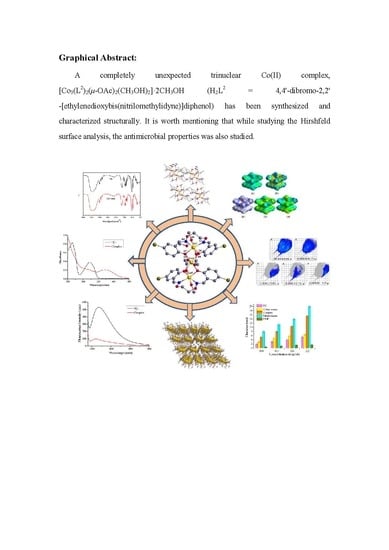An Unexpected Trinuclear Cobalt(II) Complex Based on a Half-Salamo-Like Ligand: Synthesis, Crystal Structure, Hirshfeld Surface Analysis, Antimicrobial and Fluorescent Properties
Abstract
:1. Introduction
2. Experimental
2.1. Materials and Measurements
2.2. Synthesis of HL1
2.3. Synthesis of the Co(II) Complex
2.4. Crystal Structure of the Co(II) Complex
3. Results and Discussion
3.1. IR Spectra
3.2. UV-Vis Spectra
3.3. Description of the Crystal Structure
3.4. Fluorescence Spectra
3.5. Hirshfeld Surface Analysis
3.6. Antibacterial Activities
4. Conclusions
Author Contributions
Funding
Conflicts of Interest
References
- Liu, X.; Manzurc, C.; Novoa, N.; Celedónc, S.; Carrilloc, D.; Hamon, J.R. Multidentate unsymmetrically-substituted Schiff bases and their metal complexes: Synthesis, functional materials properties, and applications to catalysis. Coord. Chem. Rev. 2018, 357, 144–172. [Google Scholar] [CrossRef]
- Liu, X. Recent developments in penta-, hexa- and heptadentate Schiff base ligands and their metal complexes. Coord. Chem. Rev. 2019, 389, 94–118. [Google Scholar] [CrossRef]
- Li, X.Y.; Kang, Q.P.; Liu, L.Z.; Ma, J.C.; Dong, W.K. Trinuclear Co(II) and mononuclear Ni(II) salamo-type bisoxime coordination compounds. Crystals 2018, 8, 43. [Google Scholar] [CrossRef]
- Zhang, L.W.; Liu, L.Z.; Wang, F.; Dong, W.K. Unprecedented fluorescent dinuclear CoII and ZnII coordination compounds with a symmetric bis(salamo)-like tetraoxime. Molecules 2018, 23, 1141. [Google Scholar] [CrossRef]
- Akine, S.; Sairenji, S.; Taniguchi, T.; Nabeshima, T. Stepwise helicity inversions by multisequential metal Exchange. J. Am. Chem. Soc. 2013, 135, 12948–12951. [Google Scholar] [CrossRef]
- Wang, P.; Zhao, L. Synthesis, structure and spectroscopic properties of the trinuclear cobalt(II) and nickel(II) complexes based on 2-hydroxynaphthaldehyde and bis(aminooxy)alkane. Spectrochim. Acta A 2015, 135, 342–350. [Google Scholar] [CrossRef]
- Akine, S.; Tadokoro, T.; Nabeshima, T. Oligometallic template strategy for synthesis of a macrocyclic dimer-type octaoxime ligand for its cooperative complexation. Inorg. Chem. 2012, 51, 11478–11486. [Google Scholar] [CrossRef]
- Akine, S.; Varadi, Z.; Nabeshima, T. Synthesis of planar metal complexes and the stacking abilities of naphthalenediol-based acyclic and macrocyclic salen-type ligands. Eur. J. Inorg. Chem. 2013, 2013, 5987–5998. [Google Scholar] [CrossRef]
- Akine, S.; Kagiyama, S.; Nabeshima, T. Modulation of multimetal complexation behavior of tetraoxime ligand by covalent transformation of olefinic functionalities. Inorg. Chem. 2010, 49, 2141–2152. [Google Scholar] [CrossRef]
- Wang, F.; Liu, L.Z.; Gao, L.; Dong, W.K. Unusual constructions of two salamo-based copper(II) complexes. Spectrochim. Acta A 2018, 203, 56–64. [Google Scholar] [CrossRef]
- Hao, J.; Li, X.Y.; Zhang, Y.; Dong, W.K. A reversible bis(salamo)-based fluorescence sensor for selective detection of Cd2+ in water-containing systems and food samples. Materials 2018, 11, 523. [Google Scholar] [CrossRef]
- Akine, S.; Hotate, S.; Nabeshima, T. A molecular leverage for helicity control and helix inversion. J. Am. Chem. Soc. 2011, 133, 13868–13871. [Google Scholar] [CrossRef]
- Akine, S.; Matsumoto, T.; Sairenji, S.; Nabeshima, T. Synthesis of acyclic tetrakis- and pentakis(N2O2) ligands for single-helical heterometallic complexes with a greater number of winding turns. Supramol. Chem. 2011, 23, 106–112. [Google Scholar] [CrossRef]
- Chin, T.K.; Endud, S.; Jamil, S.; Budagumpi, S.; Lintang, H.O. Oxidative dimerization of o-aminophenol by heterogeneous mesoporous material modified with biomimetic salen-type copper(II) complex. Catal. Lett. 2013, 143, 282–288. [Google Scholar] [CrossRef]
- Chen, C.Y.; Zhang, J.W.; Zhang, Y.H.; Yang, Z.H.; Wu, H.L.; Pan, G.L.; Bai, Y.C. Gadolinium(III) and dysprosium(III) complexes with a Schiff base bis(N-salicylidene)-3-oxapentane-1,5-diamine: Synthesis, characterization, antioxidation, and DNA-binding studies. J. Coord. Chem. 2015, 68, 1054–1071. [Google Scholar] [CrossRef]
- Wu, H.L.; Wang, H.; Wang, X.L.; Pan, G.L.; Shi, F.R.; Zhang, Y.H.; Bai, Y.C.; Kong, J. V-shaped ligand bis(2-benzimidazolylmethyl)amine containing three copper(II) ternary complexes: Synthesis, structure, DNA binding properties and antioxidant activity. New J. Chem. 2014, 38, 1052–1061. [Google Scholar] [CrossRef]
- Zhang, H.; Xu, Y.L.; Wu, H.L.; Aderinto, S.O.; Fan, X.Y. Mono-, bi- and multi-nuclear silver complexes constructed from bis(benzimidazole)-2-oxapropane ligands and methacrylate: Syntheses, crystal structures, DNA-binding properties and antioxidant activities. RSC Adv. 2016, 6, 83697–83708. [Google Scholar] [CrossRef]
- Zhang, Y.; Liu, L.Z.; Pan, Y.Q.; Dong, W.K. Structural characterized homotrinuclear ZnII bis(salamo)-based coordination compound: Hirshfeld surfaces, fluorescent and antimicrobial properties. Crystals 2018, 8, 259. [Google Scholar] [CrossRef]
- Gao, L.; Liu, C.; Wang, F.; Dong, W.K. Tetra-, penta- and hexa-coordinated transition metal complexes constructedfrom coumarin-containing N2O2 ligand. Crystals 2018, 8, 77. [Google Scholar] [CrossRef]
- Chai, L.Q.; Li, Y.X.; Chen, L.C.; Zhang, J.Y.; Huang, J.J. Synthesis, X-ray structure, spectroscopic, electrochemical properties and DFT calculation of a bridged dinuclear copper(II) complex. Inorg. Chim. Acta 2016, 444, 193–201. [Google Scholar] [CrossRef]
- Dong, W.K.; Ma, J.C.; Zhu, L.C.; Zhang, Y.; Li, X.L. Four new nickel(II) complexes based on an asymmetric salamo-type ligand: Synthesis, structure, solvent effect and electrochemical property. Inorg. Chim. Acta 2016, 445, 140–148. [Google Scholar] [CrossRef]
- Ren, Z.L.; Hao, J.; Hao, P.; Dong, X.Y.; Bai, Y.; Dong, W.K. Synthesis, crystal structure, luminescence and electrochemical properties of a salamo-type trinuclear cobalt(II) complex. Z. Naturforschung B 2018, 73, 203–210. [Google Scholar] [CrossRef]
- Chai, L.Q.; Tang, L.J.; Chen, L.C.; Huang, J.J. Structural, spectral, electrochemical and DFT studies of two mononuclear manganese(II) and zinc(II) complexes. Polyhedron 2017, 122, 228–240. [Google Scholar] [CrossRef]
- Song, X.Q.; Liu, P.P.; Liu, Y.A.; Zhou, J.J.; Wang, X.L. Two dodecanuclear heterometallic [Zn6Ln6] clusters constructed by a multidentate salicylamide salen-like ligand: Synthesis, structure, luminescence and magnetic properties. Dalton Trans. 2016, 45, 8154–8163. [Google Scholar] [CrossRef]
- Zhang, L.W.; Li, X.Y.; Kang, Q.P.; Liu, L.Z.; Ma, J.C.; Dong, W.K. Structures and fluorescent and magnetic behaviors of newly synthesized NiII and CuII coordination compounds. Crystals 2018, 8, 173. [Google Scholar] [CrossRef]
- Yamashita, A.; Watanabe, A.; Akine, S.; Nabeshima, T.; Nakano, M.; Yamamura, T.; Kajiwara, T. Wheel-shaped ErIIIZnII3 single-molecule magnet: A macrocyclic approach to designing magnetic anisotropy. Angew. Chem. Int. Ed. 2011, 50, 4016–4019. [Google Scholar] [CrossRef]
- Song, X.Q.; Liu, P.P.; Wang, C.Y.; Liu, Y.A.; Liu, W.S.; Zhang, M. Three sandwich-type zinc(II)-lanthanide(III) clusters: Structures, luminescence and magnetic properties. RSC Adv. 2017, 7, 22692–22698. [Google Scholar] [CrossRef]
- Zheng, S.S.; Dong, W.K.; Zhang, Y.; Chen, L.; Ding, Y.J. Four salamo-type 3d-4f hetero-bimetallic [ZnIILnIII] complexes: Syntheses, crystal structures, and luminescent and magnetic properties. New J. Chem. 2017, 41, 4966–4973. [Google Scholar] [CrossRef]
- Zhao, Q.; An, X.X.; Liu, L.Z.; Dong, W.K. Syntheses, luminescences and Hirshfeld surfaces analyses of structurally characterized homo-trinuclear ZnII and hetero-pentanuclear ZnII-LnIII (Ln=Eu, Nd) bis(salamo)-like complexes. Inorg. Chim. Acta 2019, 490, 6–15. [Google Scholar] [CrossRef]
- Wang, L.; Kang, Q.P.; Hao, J.; Dong, W.K. Two trinuclear cobalt(II) salamo-type complexes: Syntheses, crystal structures, solvent effect and fluorescent properties. Chin. J. Inorg. Chem. 2018, 34, 525–533. [Google Scholar]
- Yamamura, M.; Takizawa, H.; Sakamoto, N.; Nabeshima, T. Monomeric and dimeric red/NIR-fluorescent dipyrrin-germanium complexes: Facile monomer-dimer interconversion driven by acid/base additions. Tetrahedron Lett. 2013, 54, 7049–7052. [Google Scholar] [CrossRef]
- Peng, Y.D.; Li, X.Y.; Kang, Q.P.; An, G.X.; Zhang, Y.; Dong, W.K. Synthesis and fluorescence properties of asymmetrical salamo-type tetranuclear zinc(II) complex. Crystals 2018, 8, 107. [Google Scholar] [CrossRef]
- Dong, X.Y.; Zhao, Q.; Wei, Z.L.; Mu, H.R.; Zhang, H.; Dong, W.K. Synthesis and fluorescence properties of structurally characterized heterobimetalic Cu(II)-Na(I) bis(salamo)-based complex bearing square planar, square pyramid and triangular prism geometries of metal centers. Molecules 2018, 23, 1006. [Google Scholar] [CrossRef]
- Kang, Q.P.; Li, X.Y.; Zhao, Q.; Ma, J.C.; Dong, W.K. Structurally characterized homotrinuclear salamo-type nickel(II) complexes: Synthesis, solvent effect and fluorescence properties. Appl. Organomet. Chem. 2018, 32, e4379. [Google Scholar] [CrossRef]
- Sakamoto, N.; Ikeda, C.; Yamamura, M.; Nabeshima, T. Structural interconversion and regulation of optical properties of stable hypercoordinate dipyrrin-silicon complexes. J. Am. Chem. Soc. 2011, 133, 4726–4729. [Google Scholar] [CrossRef]
- Ikeda, C.; Ueda, S.; Nabeshima, T. Aluminium complexes of N2O2-type dipyrrins: The first hetero-multinuclear complexes of metallo-dipyrrins with high fluorescence quantum yields. Chem. Commun. 2009, 2544–2546. [Google Scholar] [CrossRef]
- Dong, X.Y.; Zhao, Q.; Kang, Q.P.; Mu, H.R.; Zhang, H.; Dong, W.K. Self-assembly of 3d-4f ZnII-LnIII(Ln=Ho and Er) bis(salamo)-based complexes: Controlled syntheses, structures and fluorescence properties. Crystals 2018, 8, 230. [Google Scholar] [CrossRef]
- Yang, Y.H.; Hao, J.; Dong, Y.J.; Wang, G.; Dong, W.K. Two Znic(II) complexes constructed from a bis(salamo)-type tetraoxime ligand: Syntheses, crystal structures and luminescence properties. Chin. J. Inorg. Chem. 2017, 33, 1280–1292. [Google Scholar]
- Hu, J.H.; Sun, Y.; Qi, J.; Li, Q.; Wei, T.B. A new unsymmetrical azine derivative based on coumarin group as dual-modal sensor for CN− and fluorescent “OFF-ON” for Zn2+. Spectrochim. Acta A 2017, 175, 125–133. [Google Scholar] [CrossRef]
- Sun, Y.; Hu, J.H.; Qi, J.; Li, J.B. A highly selective colorimetric and “turn-on” fluorimetric chemosensor for detecting CN− based on unsymmetrical azine derivatives in aqueous media. Spectrochim. Acta A 2016, 167, 101–105. [Google Scholar] [CrossRef]
- Akine, S.; Piao, S.J.; Miyashita, M.; Nabeshima, T. Cage-like tris(salen)-type metallocryptand for cooperative guest recognition. Tetrahedron Lett. 2013, 54, 6541–6544. [Google Scholar] [CrossRef]
- Nabeshima, T.; Yamamura, M. Cooperative formation and functions of multimetal supramolecular systems. Pure Appl. Chem. 2013, 85, 763–776. [Google Scholar] [CrossRef]
- Zhang, H.J.; Chang, J.; Jia, H.R.; Sun, Y.X. Syntheses, supramolecular structures and spectroscopic properties of Cu(II) and Ni(II) complexes with Schiff base containing oxime group. Chin. J. Inorg. Chem. 2018, 34, 2261–2270. [Google Scholar]
- Jia, H.R.; Li, J.; Sun, Y.X.; Guo, J.Q.; Yu, B.; Wen, N.; Xu, L. Two supramolecular cobalt(II) complexes: Syntheses, crystal structures, spectroscopic behaviors, and counter anion effects. Crystals 2017, 7, 247. [Google Scholar]
- Zhou, L.; Hu, Q.; Chai, L.Q.; Mao, K.H.; Zhang, H.S. X-ray characterization, spectroscopic, DFT calculations and Hirshfeld surface analysis of two 3-D supramolecular mononuclear zinc(II) and trinuclear copper(II) complexes. Polyhedron 2019, 158, 102–116. [Google Scholar] [CrossRef]
- Chang, J.; Zhang, H.J.; Jia, H.R.; Sun, Y.X. Binuclear nickel(II) and zinc(II) complexes based on 2-amino-3-hydroxy-pyridine Schiff base: Syntheses, supramolecular structures and spectral properties. Chin. J. Inorg. Chem. 2018, 34, 2097–2107. [Google Scholar]
- Spackman, M.A.; McKinnon, J.J.; Jayatilaka, D. Electrostatic potentials mapped on Hirshfeld surfaces provide direct insight into intermolecular interactions in crystals. Cryst. Eng. Commun 2008, 10, 377–388. [Google Scholar] [CrossRef]
- An, X.X.; Zhao, Q.; Mu, H.R.; Dong, W.K. A new half-salamo-based homo-trinuclear nickel(II) complex: Crystal structure, Hirshfeld surface analysis, and fluorescence properties. Crystals 2019, 9, 101. [Google Scholar] [CrossRef]
- Dong, X.Y.; Kang, Q.P.; Li, X.Y.; Ma, J.C.; Dong, W.K. Structurally characterized solvent-induced homotrinuclear cobalt(II) N2O2-donor bisoxime-type complexes. Crystals 2018, 8, 139. [Google Scholar] [CrossRef]
- Dong, W.K.; Lan, P.F.; Zhou, W.M.; Zhang, Y. Salamo-type trinuclear and tetranuclear cobalt(II) complexes based on a new asymmetry salamo-type ligand: Syntheses, crystal structures and fluorescence properties. J. Coord. Chem. 2016, 65, 1272–1283. [Google Scholar] [CrossRef]
- Dong, W.K.; Zhang, J.T.; Dong, Y.J.; Zhang, Y.; Wang, Z.K. Construction of mononuclear copper(II) and trinuclear cobalt(II) complexes based on asymmetric salamo-type ligands. Z. Anorg. Allg. Chem. 2016, 642, 189–196. [Google Scholar] [CrossRef]
- Dong, W.K.; Zheng, S.S.; Zhang, J.T.; Zhang, Y.; Sun, Y.X. Luminescent properties of heterotrinuclear 3d–4f complexes constructed from a naphthalenediol-based acyclic bis(salamo)-type ligand. Spectrochim. Acta A 2017, 184, 141–150. [Google Scholar] [CrossRef]
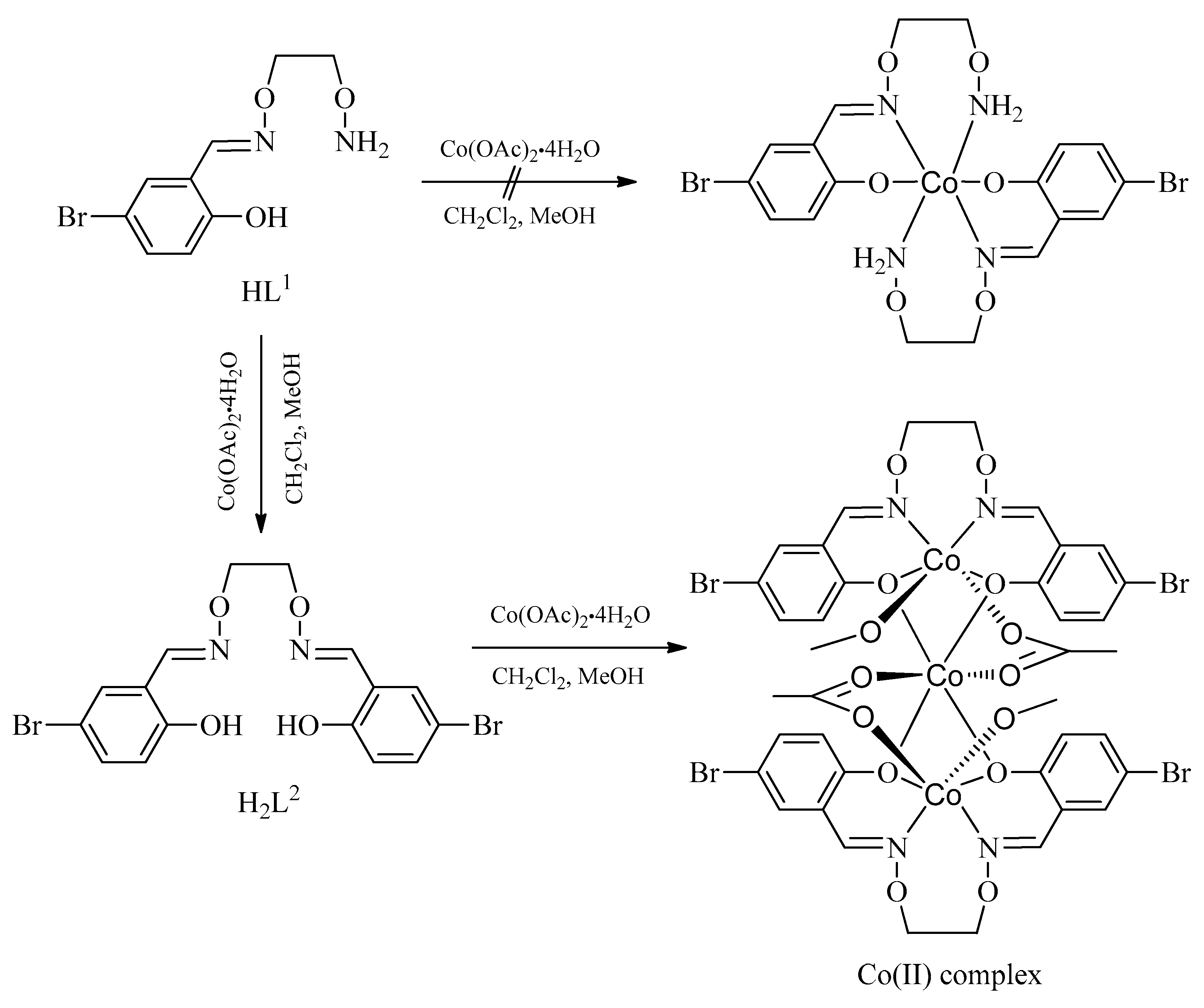
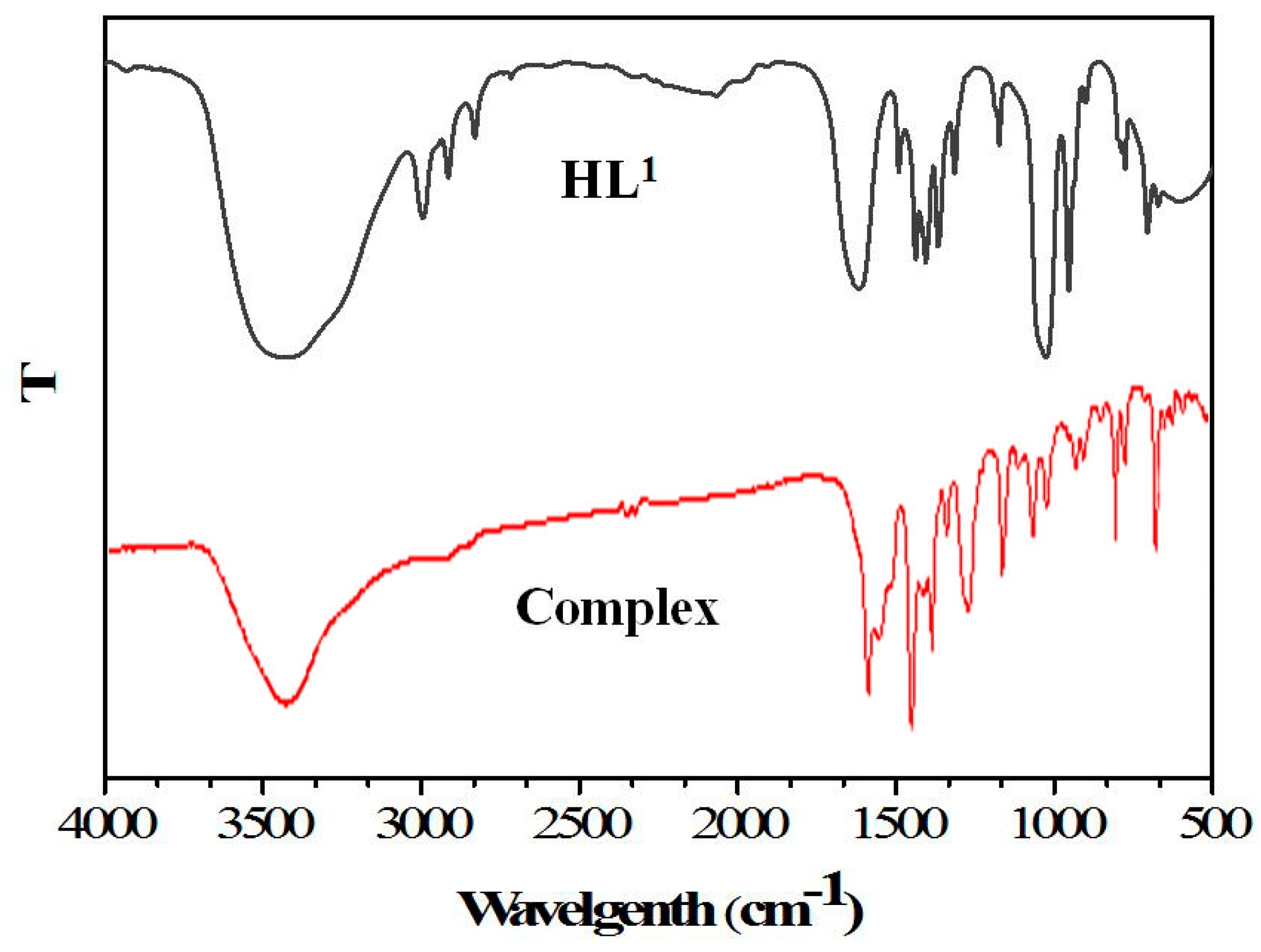
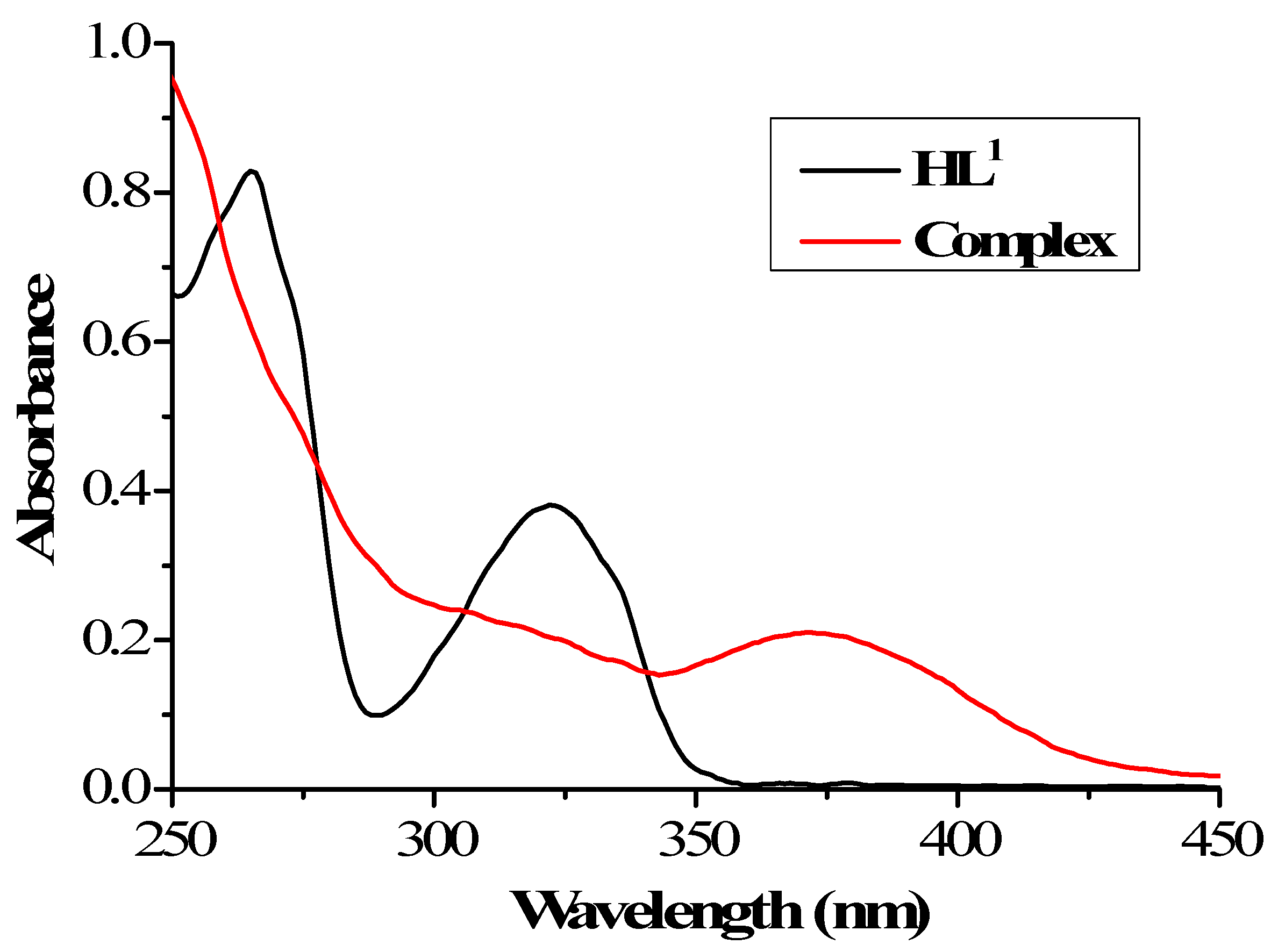
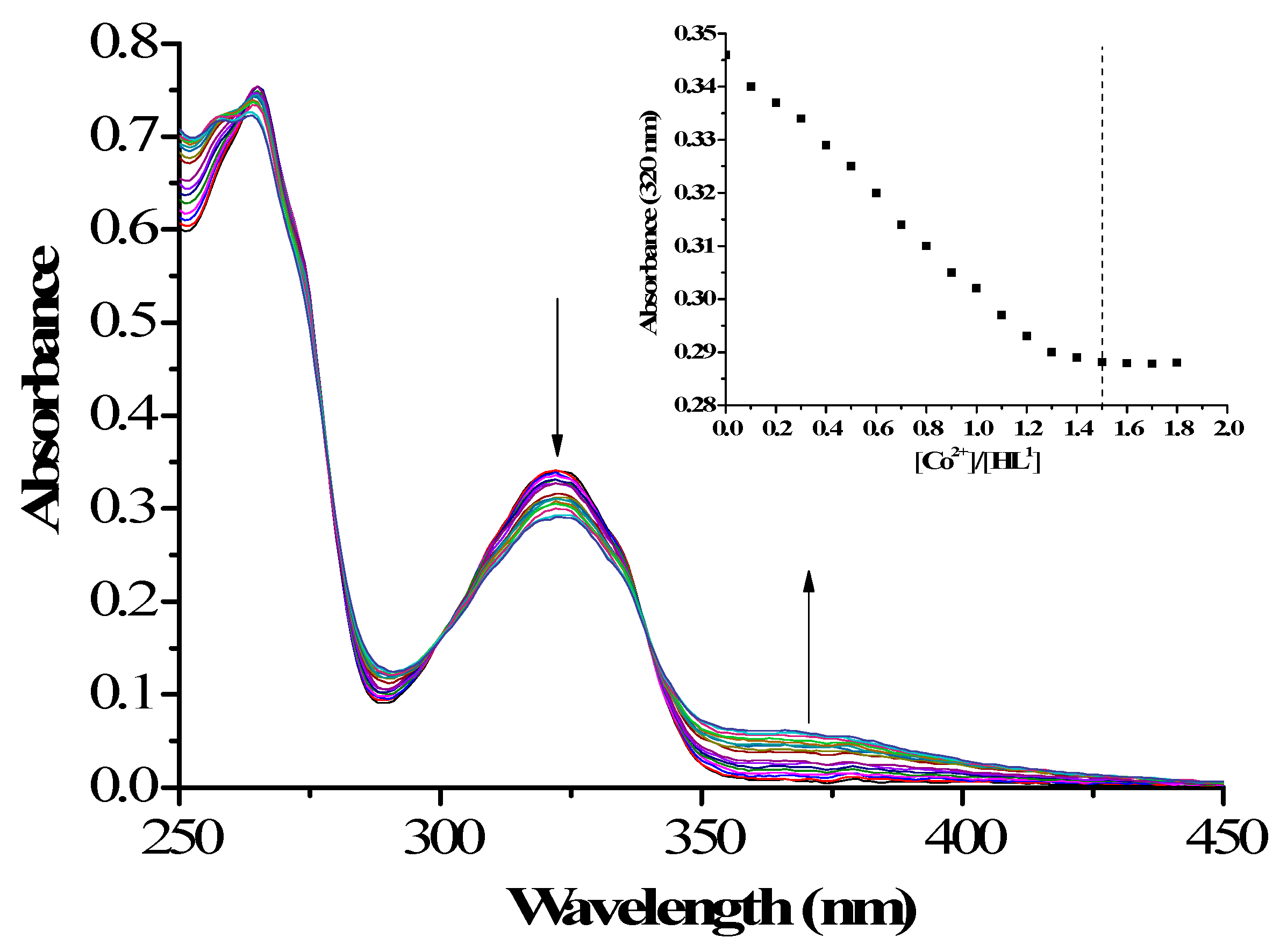
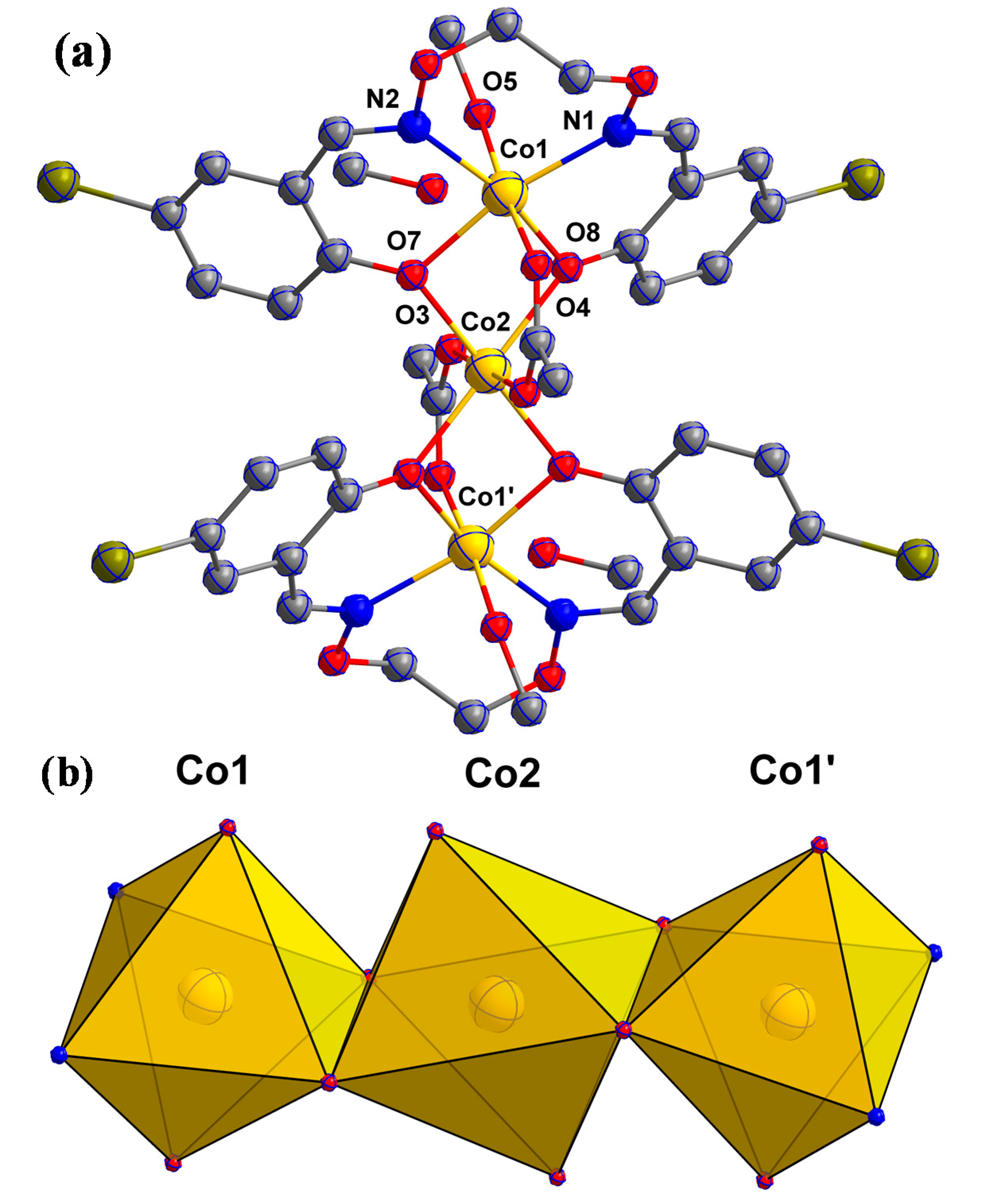
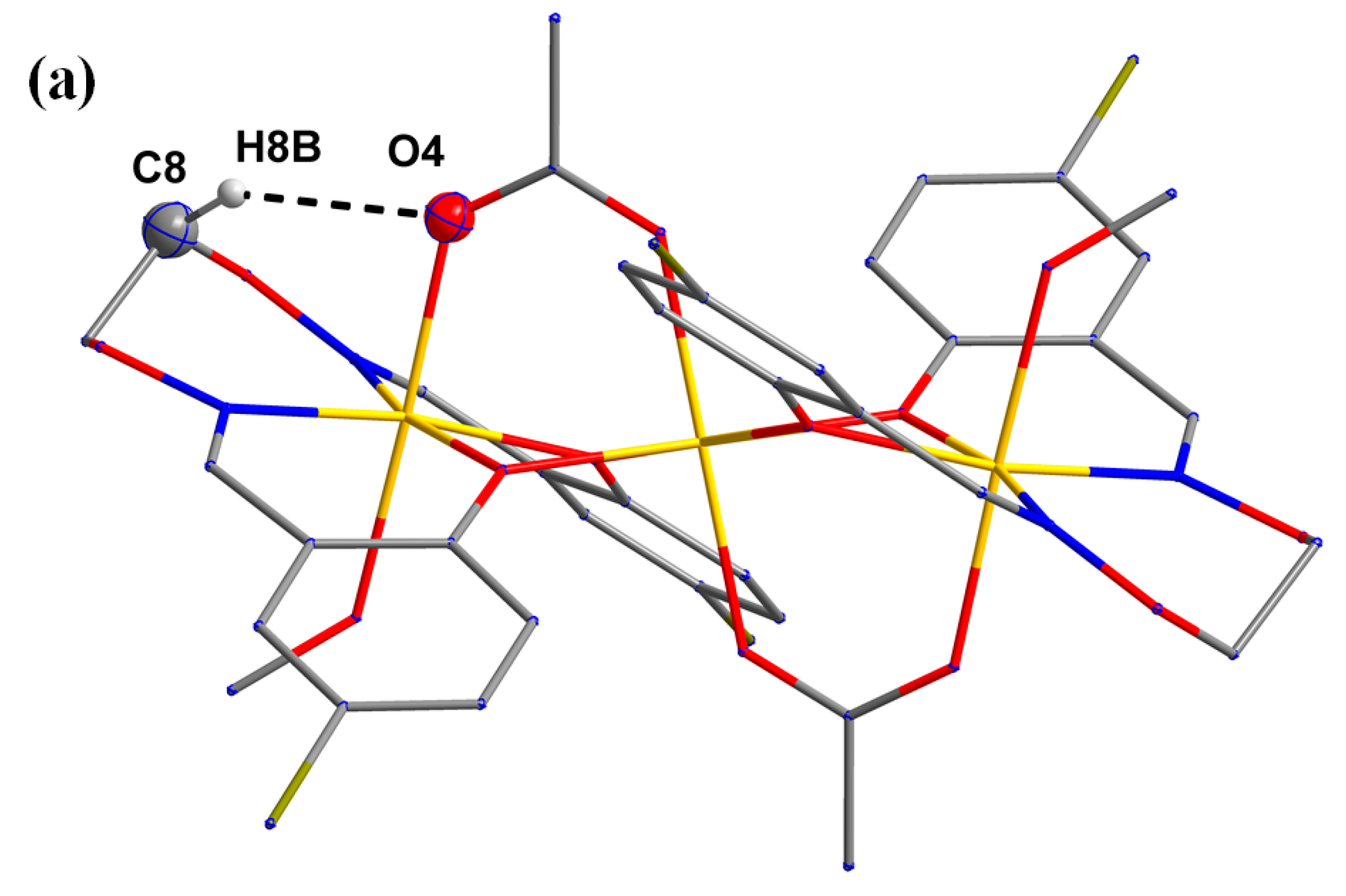
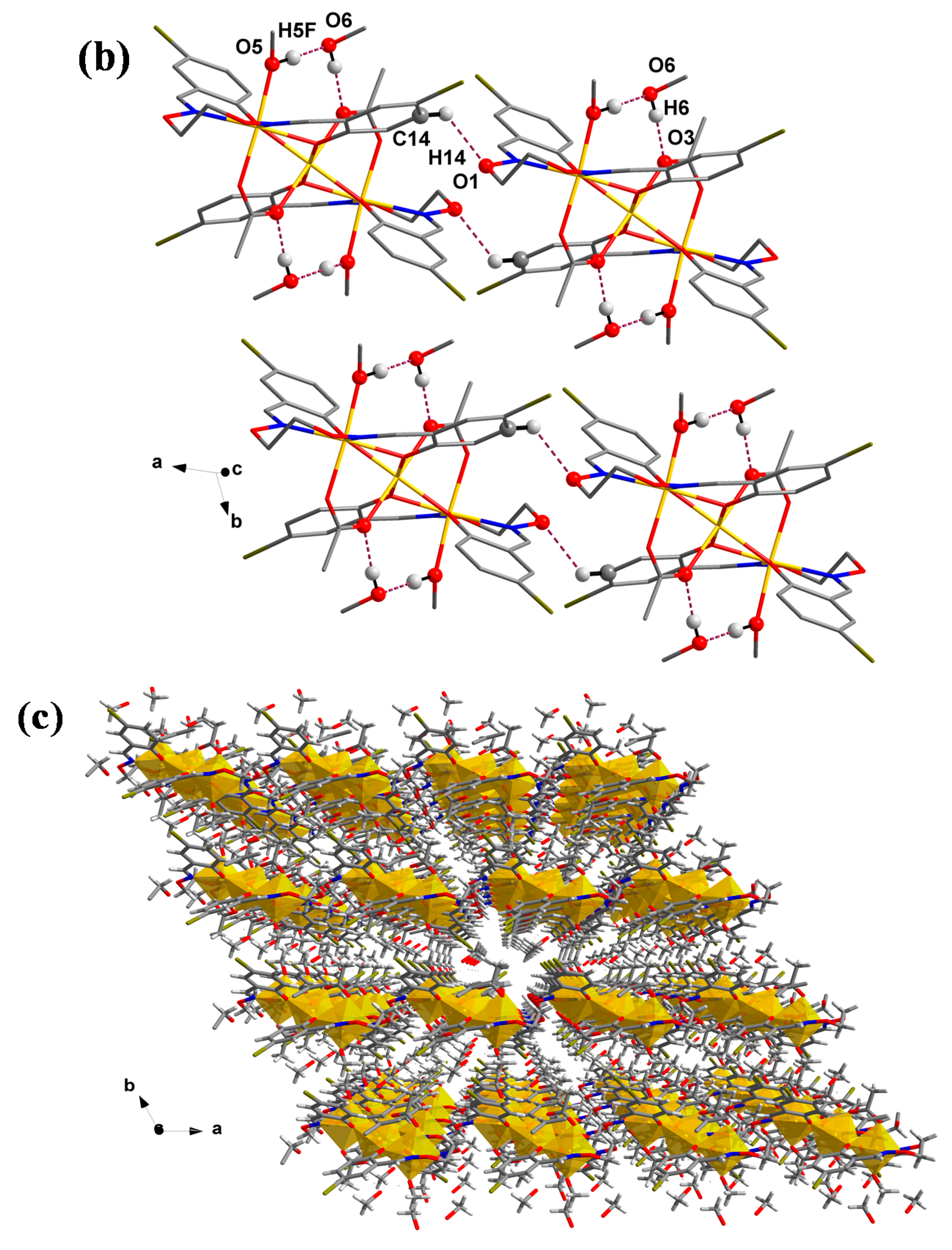
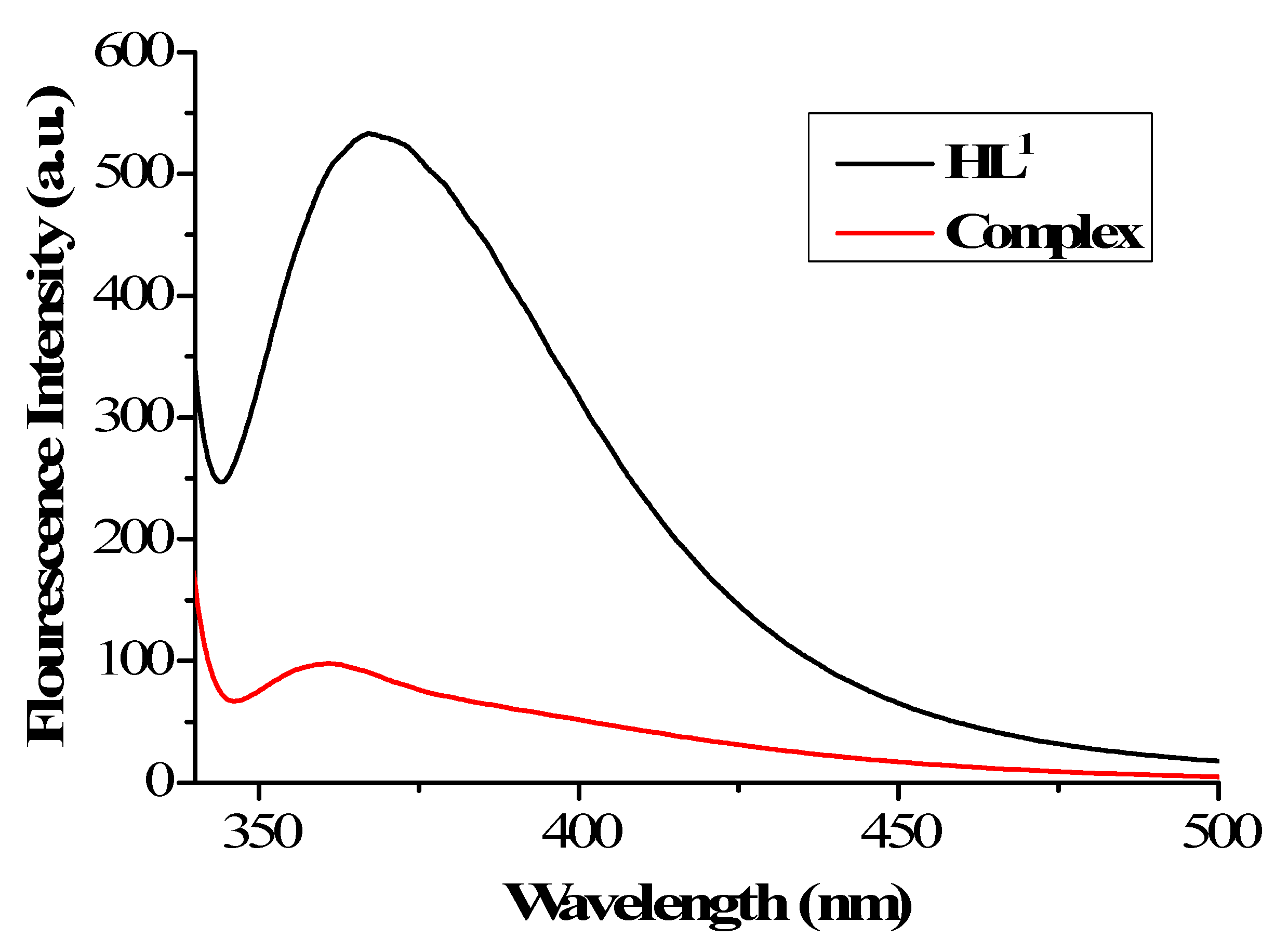
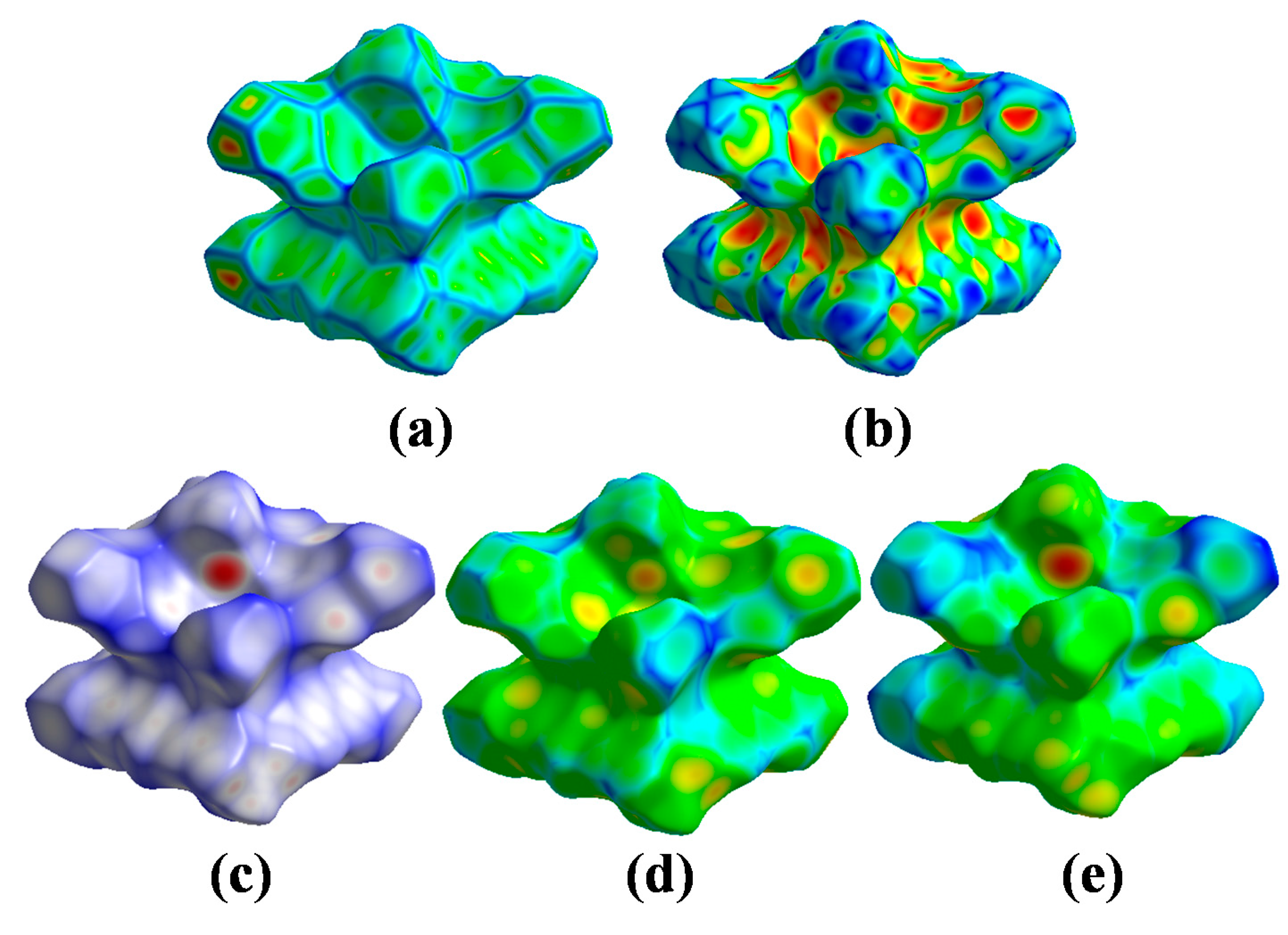
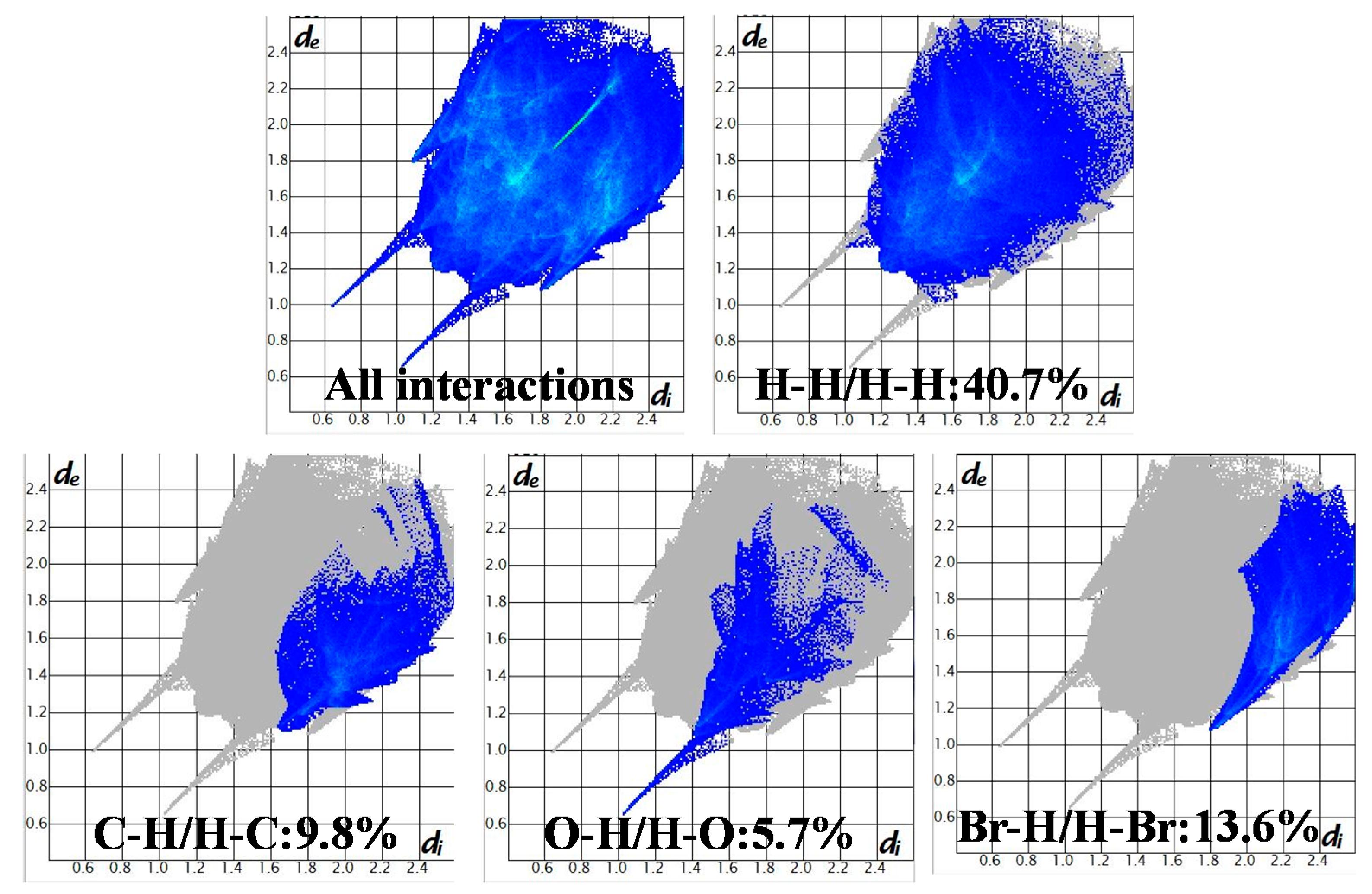
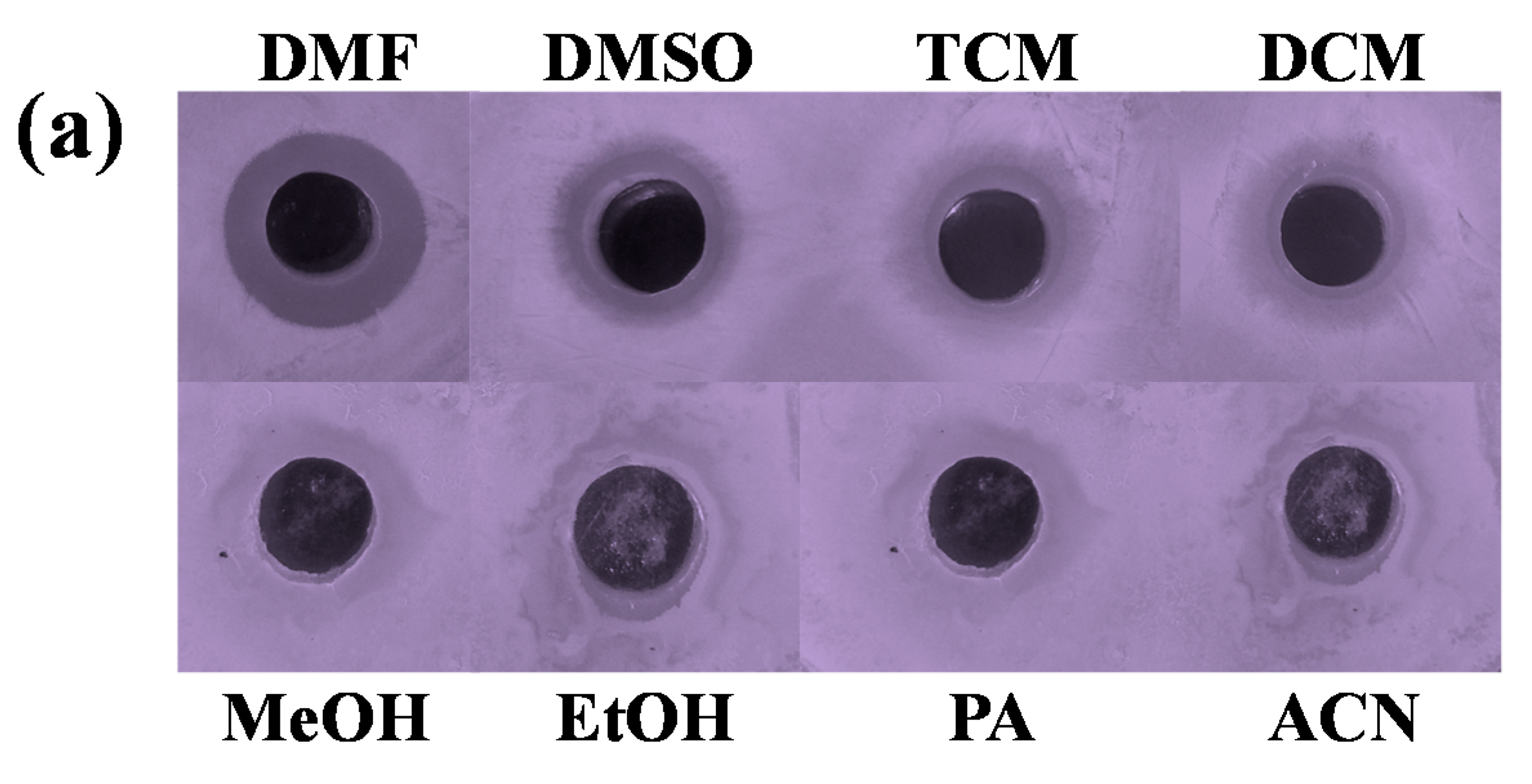

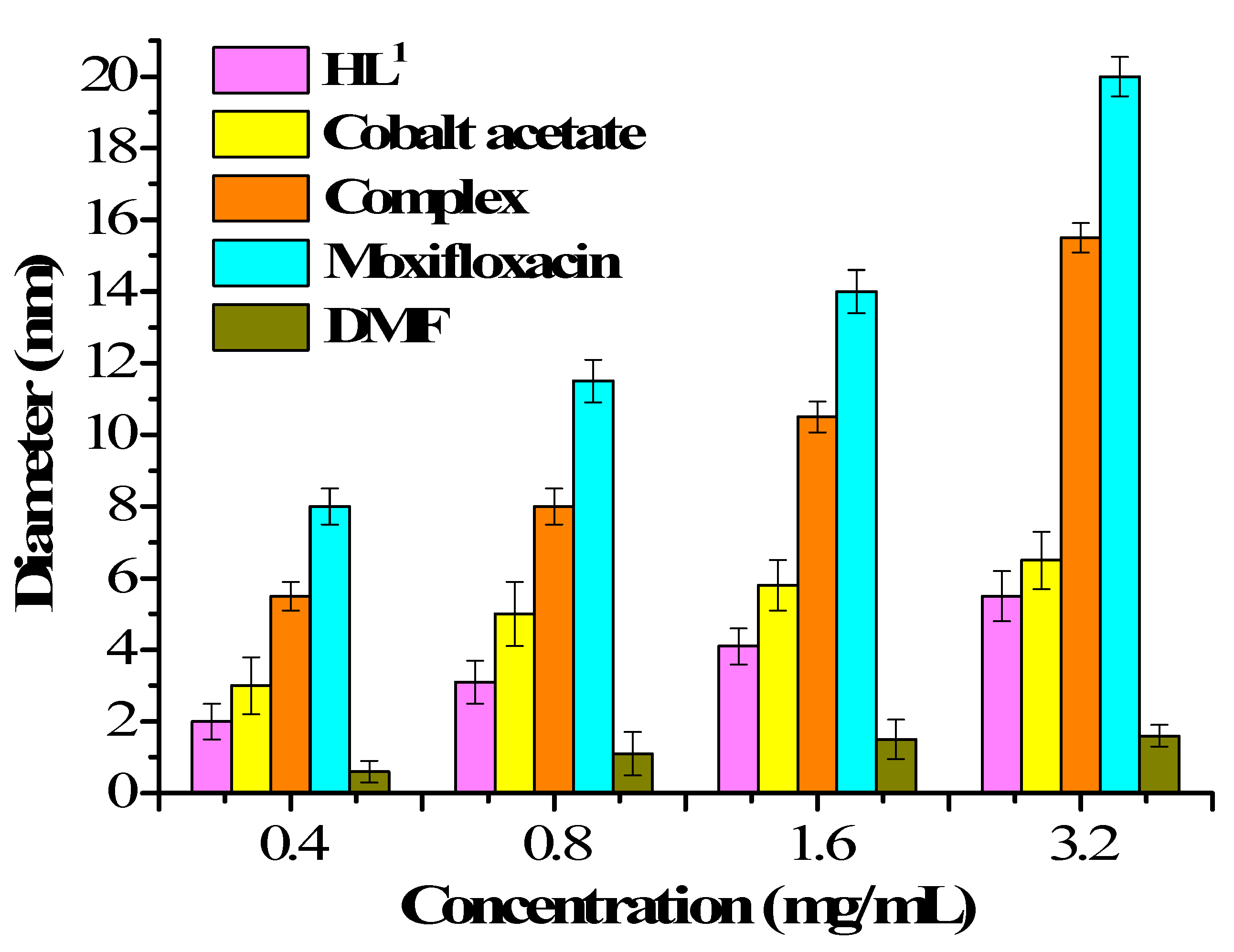
| Compound | The Co(II) Complex |
|---|---|
| Formula | C40H46Br4Co3N4O16 |
| Formula weight | 1335.20 |
| Temperature (K) | 173 |
| Radiation (Å) | 0.71073 |
| Crystal system | triclinic |
| Space group | P−1 |
| a (Å) | 10.9896(7) |
| b (Å) | 11.0596(7) |
| c (Å) | 11.2998(7) |
| α (°) | 99.760(2) |
| β (°) | 94.287(2) |
| γ (°) | 116.021(1) |
| V (Å3) | 1198.94(13) |
| Z | 1 |
| Dcalc (g·cm−3) | 1.849 |
| µ (mm−1) | 4.430 |
| F (000) | 663 |
| Crystal size (mm) | 0.17 × 0.19 × 0.22 |
| θ Range (°) | 2.18–25.01 |
| Index ranges | −13 ≤ h ≤ 13 |
| −13 ≤ k ≤ 13 | |
| −12 ≤ l ≤ 13 | |
| Completeness to θ | 97.7% (θ = 25.01) |
| Tot. Data | 8056 |
| Uniq. Data | 4130 |
| R (int) | 0.017 |
| Observed Data | 3819 |
| Nref/Npar | 4130/308 |
| GOF | 1.055 |
| R [I > 2σ(I)] | R1 =0.0268, wR2 = 0.0711 |
| Largest differences peak and hole (e Å−3) | 0.67/−0.56 |
| Bond | Lengths | Bond | Lengths |
|---|---|---|---|
| Co1–O4 | 2.058(2) | Co2–O3 | 2.1243(19) |
| Co1–O5 | 2.114(2) | Co2–O7 | 2.1109(18) |
| Co1–O7 | 2.063(2) | Co2–O8 | 2.104(2) |
| Co1–O8 | 2.0538(18) | Co2–O3 #1 | 2.1243(19) |
| Co1–N1 | 2.131(2) | Co2–O7 #1 | 2.1109(18) |
| Co1–N2 | 2.127(2) | Co2–O8 #1 | 2.104(2) |
| Bond | Angles | Bond | Angles |
| O4–Co1–O5 | 176.02(9) | O3–Co2–O7 | 86.91(7) |
| O4–Co1–O7 | 91.12(8) | O3–Co2–O8 | 88.95(8) |
| O4–Co1–O8 | 93.46(8) | O3–Co2–O3 #1 | 180.00 |
| O4–Co1–N1 | 86.33(9) | O3–Co2–O7 #1 | 93.09(7) |
| O4–Co1–N2 | 93.12(8) | O3–Co2–O8 #1 | 91.06(8) |
| O5–Co1–O7 | 92.86(8) | O7–Co2–O8 | 77.29(7) |
| O5–Co1–O8 | 87.06(8) | O3 #1–Co2–O7 | 93.09(7) |
| O5–Co1–N1 | 89.75(9) | O7–Co2–O7 #1 | 180.00 |
| O5–Co1–N2 | 87.29(8) | O7–Co2–O8 #1 | 102.71(7) |
| O7–Co1–O8 | 79.48(8) | O3 #1–Co2–O8 | 91.06(8) |
| O7–Co1–N1 | 166.34(8) | O7 #1–Co2–O8 | 102.71(7) |
| O7–Co1–N2 | 87.42(8) | O8–Co2–O8 #1 | 180.00 |
| O8–Co1–N1 | 87.27(9) | O3 #1–Co2–O7 #1 | 86.91(7) |
| O8–Co1–N2 | 165.44(9) | O3 #1–Co2–O8 #1 | 88.95(8) |
| N1–Co1–N2 | 106.11(9) | O7 #1–Co2–O8 #1 | 77.29(7) |
| D–H···A | d(D–H) | d(H···A) | d(D···A) | ∠D–H···A | Symmetry Code |
|---|---|---|---|---|---|
| O5–H5F···O6 | 0.91 | 1.70 | 2.611(3) | 175 | |
| C6–H6···O3 | 0.84 | 1.83 | 2.666(3) | 176 | 1−x, 1−y, 1−z |
| C8–H8B···O4 | 0.99 | 2.36 | 3.212(4) | 143 | |
| C14–H14···O1 | 0.95 | 2.60 | 3.307(4) | 132 | 1+x, y, z |
© 2019 by the authors. Licensee MDPI, Basel, Switzerland. This article is an open access article distributed under the terms and conditions of the Creative Commons Attribution (CC BY) license (http://creativecommons.org/licenses/by/4.0/).
Share and Cite
Li, R.-Y.; An, X.-X.; Wu, J.-L.; Zhang, Y.-P.; Dong, W.-K. An Unexpected Trinuclear Cobalt(II) Complex Based on a Half-Salamo-Like Ligand: Synthesis, Crystal Structure, Hirshfeld Surface Analysis, Antimicrobial and Fluorescent Properties. Crystals 2019, 9, 408. https://doi.org/10.3390/cryst9080408
Li R-Y, An X-X, Wu J-L, Zhang Y-P, Dong W-K. An Unexpected Trinuclear Cobalt(II) Complex Based on a Half-Salamo-Like Ligand: Synthesis, Crystal Structure, Hirshfeld Surface Analysis, Antimicrobial and Fluorescent Properties. Crystals. 2019; 9(8):408. https://doi.org/10.3390/cryst9080408
Chicago/Turabian StyleLi, Ruo-Yan, Xiao-Xin An, Juan-Li Wu, You-Peng Zhang, and Wen-Kui Dong. 2019. "An Unexpected Trinuclear Cobalt(II) Complex Based on a Half-Salamo-Like Ligand: Synthesis, Crystal Structure, Hirshfeld Surface Analysis, Antimicrobial and Fluorescent Properties" Crystals 9, no. 8: 408. https://doi.org/10.3390/cryst9080408
APA StyleLi, R.-Y., An, X.-X., Wu, J.-L., Zhang, Y.-P., & Dong, W.-K. (2019). An Unexpected Trinuclear Cobalt(II) Complex Based on a Half-Salamo-Like Ligand: Synthesis, Crystal Structure, Hirshfeld Surface Analysis, Antimicrobial and Fluorescent Properties. Crystals, 9(8), 408. https://doi.org/10.3390/cryst9080408




